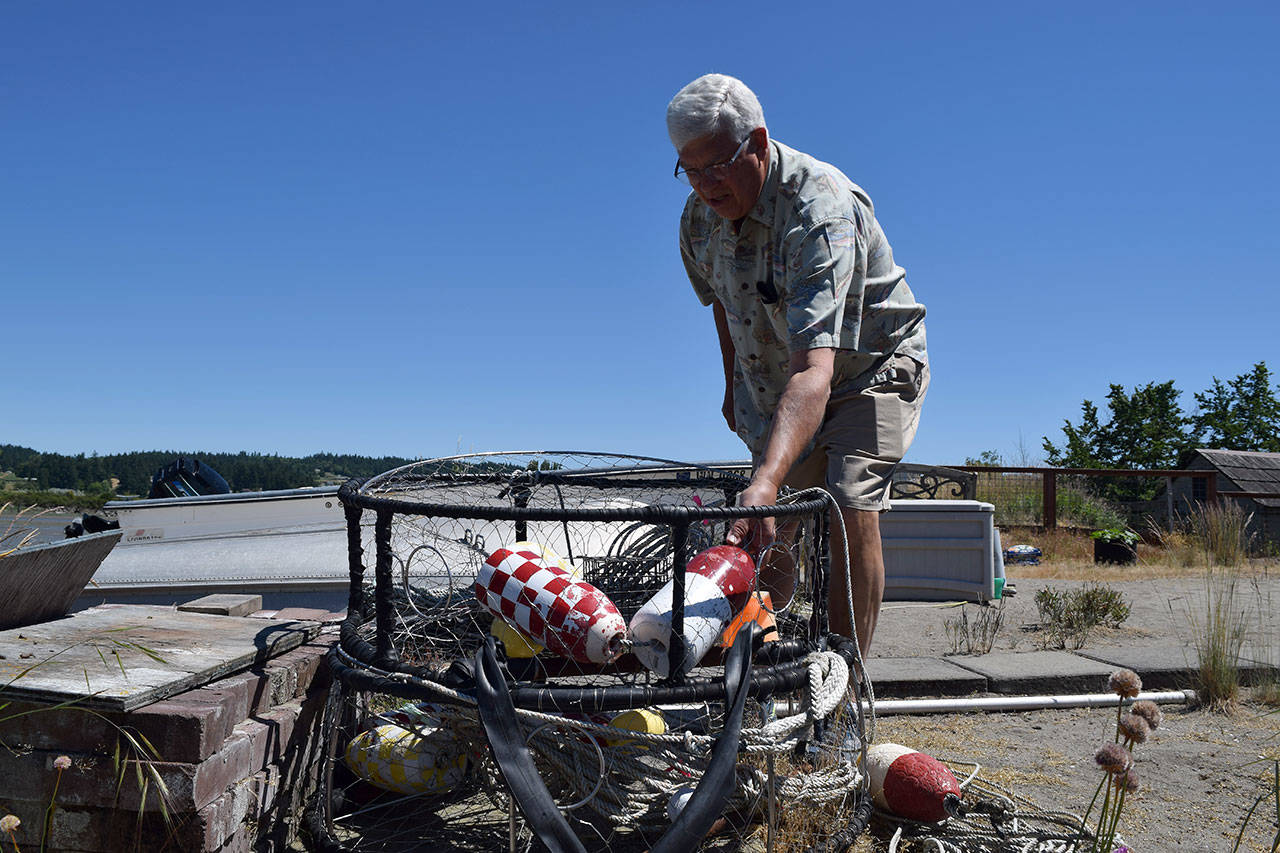As July draws closer, South Whidbey residents are beginning to dust off their crab pots in preparation for the 2017 summer crabbing season.
Seeing as how Puget Sound is in for yet another limited salmon season, many may look forward to their summer bounty having 10 legs.
Luckily, Washington Department of Fish and Wildlife say Dungeness crab “remain abundant throughout most of Puget Sound.”
“Long ago, crabbing was extra because you’d always have salmon, and you’d put a crab pot out as an addition,” Bill Haroldson, South Whidbey Historical Society president, said. “Now with so much of the fishing closed off, it feels like a lot of people only go crabbing.”
Summer crabbing season in Puget Sound waters opens Saturday, July 1 at sunrise and runs until Sept. 4. The rules set out by Washington Department of Fish and Wildlife remains the same as previous years: crabbers are limited to five male Dungeness crab per day with a minimum 6.25 inches in width. Up to six red rock crab of either sex can be caught daily with a minimum size of five inches. Soft shell crabs must be returned. All catches must be noted in the field in a catch record card.
Crabbing is allowed Thursday through Monday.
According to Haroldson and Sunlight Beach resident Cliff Slade, everyone seems to have their own theories and tricks for catching the most crab. Trying to find South Whidbey’s “crabbing master” is an impossible task, as the methods vary by person and crabbing “secrets” are often kept close. One of Slade’s neighbors, a surgeon, wears nitrile gloves to limit the human scent on his bait.
Others have practices only they know.
“There does seem to be a lot of secrets and even superstitions when it comes to crabbing,” Slade said. “Everybody seems to have their own way of doing it. Personally, I don’t have any family secrets, but I know neighbors do.”
A common means of catching crab is with a boat, dropping a pot in 30-60 feet of water, with 80 feet “the furthest I’ll go,” according to Slade. The deeper the pot is dropped, the more cautious crabbers should be about losing their gear in the currents, particularly if it’s in an area close to heavy vessel traffic, such as Useless Bay. Those crabbing in deeper waters should use heavier pots, Slade said; he uses 36-inch, 50-pound commercial traps.
Those without boats can set their traps out by foot during low tide and return the next day for their bounty. It used to be more common when Slade was crabbing in Useless Bay 60 years ago with his grandparents, but islanders such as Scott Waltenbaugh, South Whidbey Fishin’ Club Program Coordinator, continue to make the trek on foot.
“Part of the fun is the half mile walk during low tide,” Waltenbaugh said. “For me, crabbing is all about being out in the elements.”
Finally, some crab from docks by just baiting and dropping a small pot over the side for short periods. Be sure to check facility regulations, however, as not all docks allow crab fishing or have special rules.
There are a number of areas around Whidbey Island that serve as prime crabbing spots. Holmes Harbor is said to be stocked with Dungeness, while Slade and Haroldson say Saratoga Passage in marine area 8-2 is another bountiful stretch on the South End. On the North End, Slade said he hears Cornet Bay is one of the best spots on the island.
Seasoned crabbers will say crab bait is the most important aspect of a good catch. Since crabs are bottom-feeding scavengers, using bait found in the ocean tends to attract the highest numbers. Most agree that salmon frames — salmon heads, spines and guts — are the best bait, but it’s become more expensive as salmon fishing has been severely limited in recent years. Others use shellfish, while the old turkey leg recipe is another widely used attractant.
“In the past, there was salmon to be caught, so you could put the leftovers in the pot,” Haroldson said. “There’s no way in the world I could use fresh salmon heads this year with the way salmon fishing has been.”
Washington Department of Fish and Wildlife says crabbers should keep an eye out this year for an invasive species that is damaging Puget Sound’s shellfish stock, the European green crab. The species aren’t widespread throughout the Sound yet, but the department is wary of their presence as they are believed to have contributed to “dramatic declines” in soft shell clam fisheries from Maine to Nova Scotia in the 1950s. According to the department, the crab can be best identified by the five “spines or teeth on each side of the shell,” as they can vary in color from a dark green to a reddish hue.
Slade says the shellfish bounty seems high as ever, and might even be healthier than it was growing up 60 years ago, before it was regulated by the fish and wildlife department. Of course, the catch varies depending on where traps are dropped and what bait is used, but he says there seems to be enough crab to go around when the season is in session.
That’s good news for him, since the excitement of crabbing comes from pulling up a full pot.
“What I enjoy about crabbing season is the uncertainty about it, since you never know what you’re going to pull up,” Slade said. “There’s a feeling of excitement when you pull up a full pot of crabs just looking at you.”


